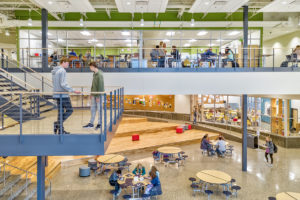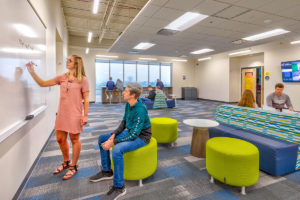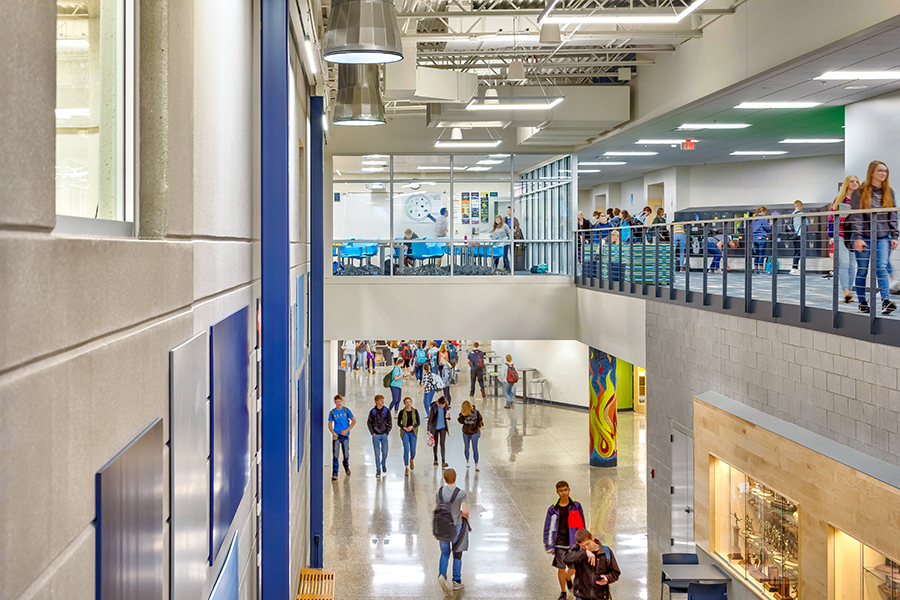Peter Baldwin is President of AMDG Architecture in Grand Rapids, Michigan, where he has worked for over 25 years. In the past 12 years the firm has worked on educational buildings for Christian educational institutions throughout the Midwest. Peter’s passion for his work stems from the belief that architecture has the power to build community and strengthen mission through the transformation of space.
The firm’s name, AMDG, stands for Ad Majorum Gloriam Dei—”To the greater glory of God.”
CEJ: What are some key principles for designing twenty-first-century learning environments? What things are exciting, new, or maybe challenging to people who have old models in mind?
PB: I think a building starts with vision and educational delivery or pedagogy. You know—how you believe learning happens, how instruction happens. I’m not an educator, so I don’t pretend to deeply understand the science, but I think understanding of the brain, how kids learn, different levels of instruction, and personalized learning are important. There was clearly, for a century plus, this idea that everybody learned in the same way, that everybody should be in the same space, that learning was predominantly one directional, usually in pretty formatted ways, and also that it was pretty siloed. Those were the ideas that actually drove our spaces to be these singular classrooms with long class corridors.
When we think about space and learning environments today, we know they need to be way more varied, and they need to serve different masters. Teachers today are better at disseminating information in different ways: peer-to-peer, small group, large group, using the digital world to inform learning and help display it. Because there are so many things you can do, schools demand much more from the space. It has to be flexible. If you’re interested in the technical side of it, I think a good physical space or school actually has to anticipate being mangled and changed and morphed, and so we’ve kind of looked at pretty wide-spanning structural systems and things that create more flexible space so the walls within it can be moved. The old model of a load-bearing wall supported the roof, but it also created really restrictive boxes that were hard to change. The new school has to provide bigger, agile spaces, because I can’t imagine schools will be the same twenty years from now.
Creating a variety of spaces and learning opportunities is another principle. At South Christian High School [in Caledonia, Michigan], one question we were asked was, “Where does the introvert go?” I think a twenty-first-century school creates different spaces for different learners and personalities. There are pull-outs. There are small groups. There are big groups. There are spaces for quiet reflection and for loud activity.
One of the things I loved about working with [educational consultant] Frank Locker on a number of projects, that I found most inspiring, was this idea of celebrating learning, making learning visible. So I think a twenty-first-century school exhibits and celebrates the learning that’s happening in it, admitting that it’s messy and it’s real and it’s good. And that includes everything from fine arts to the sciences.
Another principle is the idea of passive supervision. A great school provides fewer cameras and less obvious security but more visual connections that are meaningful enough so a teacher can kind of send people out to do work. In one of the high schools we worked on, the staff bathrooms were at the back of the kids’ bathrooms, so the kids always knew that staff could be walking through. That’s a pretty cool example of passive supervision. It’s not overbearing. It’s designed that way.
And that’s related to another thing I think is meaningful about a school: it should presume the value and dignity of people and of itself. It shouldn’t presume that students are animals that want to destroy things. If you give them beauty, you give them quality, and you give them the right boundaries, instead of building a prison with block walls, and I think kids actually will grow to understand and appreciate those things. A great school is a place that’s trying to inspire. In a Christian school, you’re trying to find the most beautiful thing that God put into a person, right? How can students find something beautiful in themselves—the talents, the passions, the very unique things God knitted into their DNA before they were even born—in a space that is a prison, that has no natural light and no connection to nature?
So another principle, in light of creation care, is that a really great school connects deeply with nature and its natural surroundings. We got to do that at the Outdoor Learning Environmental building at Ada Christian [Ada, Michigan] and at South Christian, particularly. We were very interested in views and vistas.
Peter Baldwin is president of AMDG Architecture in Grand Rapids, Michigan, where he has worked for over twenty-five years. In the past twelve years the firm has worked on buildings for Christian educational institutions throughout the Midwest. Peter’s passion for his work stems from the belief that architecture has the power to build community and strengthen mission through the transformation of space.
The firm’s name, AMDG, stands for Ad Majorum Gloriam Dei—“To the greater glory of God.”


